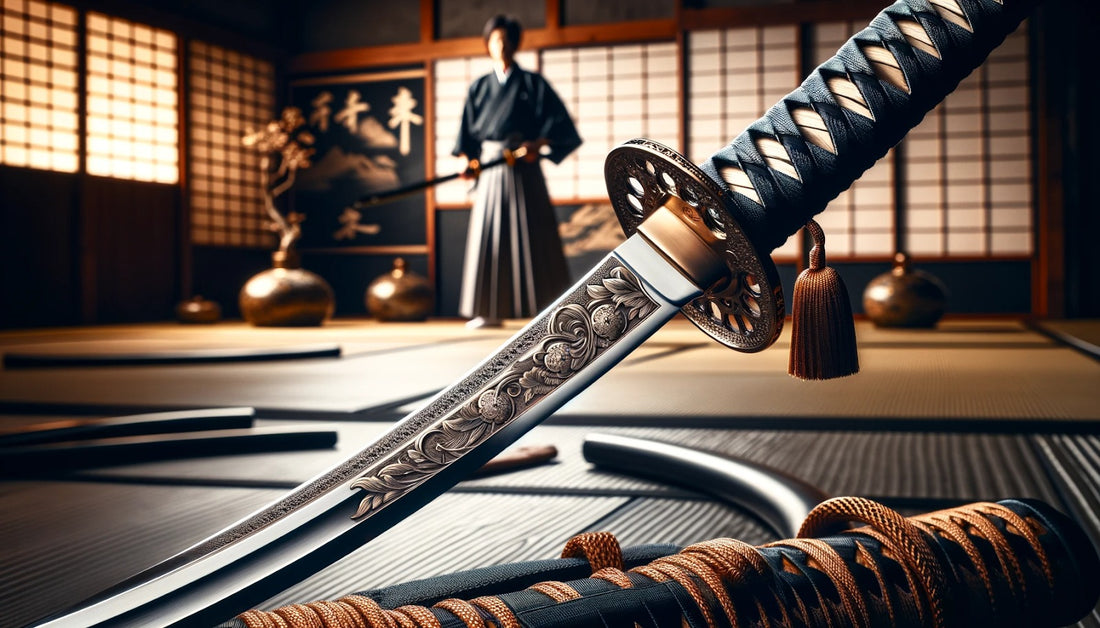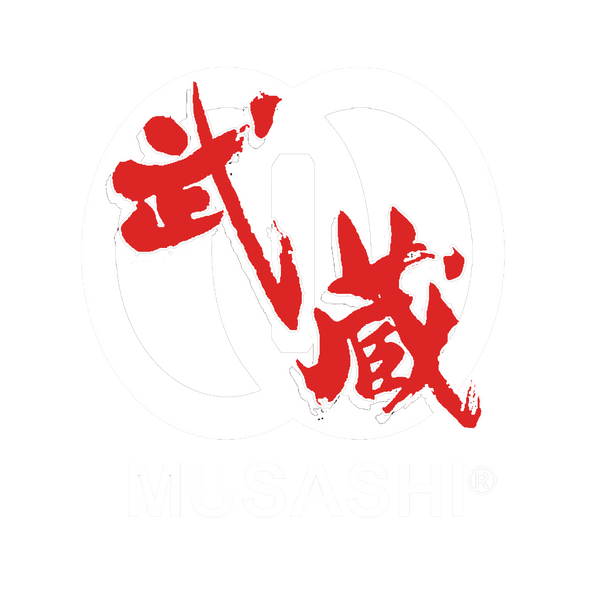
The katana, a sword that resonates with the spirit of the samurai, stands as a symbol of Japanese culture and martial arts heritage. Historically, it emerged during the feudal era of Japan, not merely as a weapon but as a testament to craftsmanship, honor, and discipline.
The katana's distinctive curved blade, meticulously crafted from high-quality steel, represents more than just a tool of war; it embodies the artistry and ethos of the Japanese warrior class. Its presence in historical tales, where samurai upheld the code of Bushido, lends it an aura of respect and fascination.
Understanding the katana extends beyond admiring its sleek appearance. Each component, from the blade to the hilt, plays a critical role in its functionality and symbolism. This guide aims to demystify the parts of a katana, providing martial arts enthusiasts with a comprehensive insight into its construction and significance.
The Blade: Heart of the Katana
The blade, or "Ha," of a katana is far more than just a sharp object; it is a masterpiece of design and craftsmanship. Central to its form is the harmonious balance between the edge and the spine, known as "Mune." The edge is meticulously sharpened for lethal efficiency, while the spine offers robust support, balancing flexibility and strength. A key characteristic of the blade is its curvature, "Sori," which is not merely aesthetic but functional, enhancing the sword's cutting power and enabling fluid, sweeping movements.
Crafting a katana blade begins with the selection of the right steel, traditionally "Tamahagane." This steel is renowned for its purity and layered construction, which results from a complex smelting process.
Skilled artisans spend countless hours folding and hammering the steel. This method distributes carbon content evenly and removes impurities, resulting in a blade that is both resilient and capable of holding a razor-sharp edge.
The art of forging a katana blade is a meticulous process, requiring precision and years of expertise. The blade undergoes a unique differential heat treatment, where the edge is cooled rapidly, and the spine is cooled slowly.
This creates a distinct hardness along the edge while maintaining flexibility in the spine, a feature essential for a blade that can withstand impact without breaking.
Katana blades vary in length, curvature, and style, reflecting the era and the specific needs of the samurai. Some blades are straighter and longer, ideal for open battlefield engagements, while others have a more pronounced curve suited for close-quarters combat. The variations in blade types also represent the evolution of sword-making techniques and the changing nature of warfare in Japanese history.
The katana blade is not just a tool of war but a symbol of the samurai's soul. Every aspect, from its curve to its composition, is a testament to the swordsmith's skills and the warrior's values. Understanding the intricacies of the katana's blade offers insight into a culture where martial prowess and artistic beauty were seamlessly intertwined.

The Hilt: More Than Just a Handle
The hilt, or "Tsuka," of a katana is a complex assembly of components, each serving a distinct purpose in functionality and aesthetics. The Tsuka is typically as long as two hands, designed to facilitate control and precision in swordplay.
The "Tsuka-ito," a braid of silk or cotton, is wrapped around it, providing a secure grip. Underneath this wrap lies the "Samegawa," or ray skin, known for its rough texture that ensures the Tsuka-ito stays tightly in place.
Integral to the hilt's design are the "Menuki," decorative elements often depicting nature or historical themes. These are not just ornamental; they are strategically placed to fit into the warrior's palm, enhancing grip comfort and reducing fatigue during extended use. The Menuki also serves as a representation of the samurai's personal tastes or beliefs.
Holding the entire assembly together is the "Mekugi," a bamboo peg that passes through the hilt and tang of the blade. This small but crucial component is vital for the sword's structural integrity, ensuring the blade remains securely attached to the hilt. The Mekugi's design allows for the disassembly of the sword for maintenance and inspection, a practical aspect of katana care.
The hilt's role in the overall balance of the katana cannot be overstated. It counterbalances the weight of the blade, allowing for swift, agile movements characteristic of katana usage. The hilt's length, curve, and weight distribution are meticulously crafted to complement the blade, ensuring the sword feels like an extension of the samurai's arm.
Moreover, the grip of the hilt is crucial for precise and effective swordplay. A well-designed Tsuka provides a comfortable yet firm grip, enabling the wielder to maneuver the blade with confidence and accuracy.
The interaction between the hand and the hilt is fundamental in executing precise cuts and defensive moves, making the hilt an essential component in katana swordsmanship.
In essence, the hilt of a katana is a marvel of design, blending functionality, art, and tradition. It embodies the meticulous attention to detail that is a hallmark of Japanese craftsmanship, making the katana a weapon and a cultural heritage.
The Guard: Balancing Defense and Aesthetics
At the intersection of function and form in a katana lies the "Tsuba," or guard, a component as critical for defense as it is expressive of artistry. The primary role of the Tsuba is to protect the hand from an opponent's blade, preventing it from sliding onto the hilt.
This disk-shaped piece, positioned between the blade and the hilt, serves as a barrier during combat, offering essential safety to the swordsman.
Traditionally, Tsubas are made from a variety of materials, including iron, copper, brass, and sometimes with precious metals for embellishment. The thickness and diameter of the Tsuba vary, tailored to balance the sword's weight and the swordsman's preference. While rooted in practicality, its design also provides a canvas for expressing artistic creativity.
The artistry found in Tsuba designs is a remarkable aspect of katana craftsmanship. Each Tsuba tells a story, from intricate landscapes and scenes from nature to depictions of historical events and mythological creatures.
The designs are not only etched or inlaid but are often raised in relief, giving them a tactile quality. These designs are more than decorative; they often symbolize the samurai's beliefs, status, or personal tastes.
The diversity in Tsuba styles reflects the evolution of Japanese art and culture. Earlier Tsubas were simple and functional but became more ornate and symbolic as the samurai era progressed. The design's choice of materials and complexity varied depending on the warrior's period, region, and status.
The Tsuba is a testament to the katana's dual nature – a lethal weapon and a work of art. It exemplifies how practicality and aesthetics can coexist, each enhancing the other. A study of the various Tsuba styles offers a glimpse into Japanese history's rich tapestry and the katana's elevated status in martial arts and culture.
The Scabbard: The Katana's Protector
The "Saya," or katana scabbard, is as vital as the sword itself. Its primary function is to protect the blade, preserving its sharpness and integrity. The Saya is not just a sheath but a finely crafted component that reflects the katana's elegance and the samurai's status.
The careful design of the Saya ensures a snug fit, allowing the blade to be drawn and re-sheathed smoothly, a critical aspect of the art of Iaido (the martial art of drawing the sword).
The craftsmanship of the Saya involves selecting the right materials and constructing it with precision. Traditionally, the Saya is made from lightweight yet durable wood, often lacquered to achieve a high-gloss finish.
This lacquer enhances the appearance and provides moisture resistance, which is crucial for the blade's preservation. The interior is often lined with soft materials to prevent scratches and to absorb any residual moisture on the blade.
The artistry in Saya making is evident in its variety. Some are simplistic and understated, focusing purely on functionality, while others are works of art adorned with intricate designs, inlays, and sometimes even gold or silver fittings. The Saya's decoration can range from subtle to elaborate, often matching the theme and style of the Tsuba and hilt fittings.
A katana's Saya is more than a protective covering; it is a statement of the sword's and its wielder's identity. The choice of materials, the level of ornamentation, and the craftsmanship involved in its creation speak volumes about the era, the swordsmith, and the samurai who bore it.
It is essential in maintaining and presenting the katana, contributing to its legacy as a revered symbol of martial prowess and artistic expression in Japanese culture.
Accessories and Ornaments: The Finishing Touches
In the world of katanas, the attention to detail extends to even the smallest components, such as the "Fuchi" and "Kashira." The Fuchi is a metal collar located at the base of the hilt, while the Kashira is the cap or pommel at the end. These elements are not merely decorative; they reinforce the Tsuka, providing structural stability to the handle.
The Fuchi, in particular, helps in securing the Tsuka-ito (handle wrap), preventing it from unraveling. Both fittings often feature intricate designs, complementing the overall aesthetics of the sword, and can range from simple, elegant patterns to elaborate depictions, often matching the theme of the Menuki and Tsuba.
Equally important are the "Habaki" and "Seppa." The Habaki is a metal collar that fits snugly around the base of the blade, just above the Tsuba. Its primary function is to secure the blade in the Saya, preventing rattling and ensuring a smooth draw.
The Seppa are washers on either side of the Tsuba, providing a tight fit and proper alignment of the blade within the hilt. These components, while small, play a crucial role in the katana's functionality and overall integrity.
Each of these accessories and ornaments, from the Fuchi and Kashira to the Habaki and Seppa, demonstrates the meticulous craftsmanship inherent in katana. They embody the fusion of utility and art, contributing to the katana's status as a weapon and a symbol of Japanese heritage.
Conclusion
In exploring the intricate components of the katana, from the blade's sharp edge to the smallest fitting on the hilt, we gain a deeper appreciation for this iconic weapon. Each part, whether the Ha, Tsuka, Tsuba, Saya, or the minute yet vital Fuchi, Kashira, Habaki, and Seppa, contributes to the katana's overall functionality and beauty.
This comprehensive understanding illuminates not just the physical attributes of the katana but also the skill, artistry, and cultural values embedded in its creation.
The katana is more than a weapon; it is a symbol of martial arts heritage, embodying the samurai spirit and Japanese craftsmanship. Its place in martial arts transcends the battlefield, reflecting a philosophy where discipline, respect, and art converge.
Understanding the parts of a katana allows us to appreciate its role in martial arts and as a significant cultural artifact, a legacy of a bygone era that continues to inspire and fascinate.
Discover the artistry of Musashi Swords, offering an exquisite range of authentic Katanas for Sale. Browse our curated collection now!


